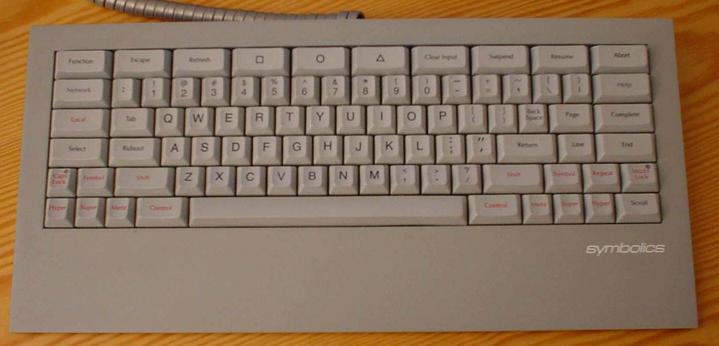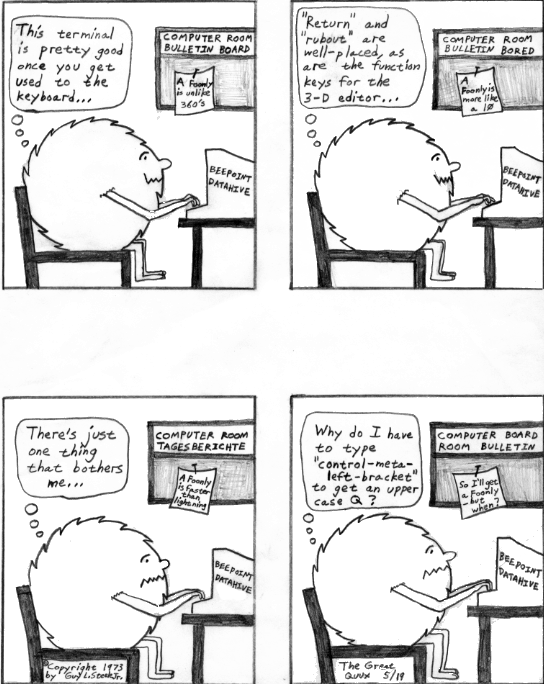space-cadet keyboard
( n.)
A now-legendary device used on MIT LISP machines, which inspired
several still-current jargon terms and influenced the design of
{EMACS}. It was equipped with no fewer than seven shift keys: four
keys for {bucky bits} (`control', `meta', `hyper', and `super') and
three regular shift keys, called `shift', `top', and `front'. Many
keys had three symbols on them: a letter and a symbol on the top, and
a Greek letter on the front. For example, the `L' key had an `L' and
a two-way arrow on the top, and the Greek letter lambda on the front.
By pressing this key with the right hand while playing an appropriate
`chord' with the left hand on the shift keys, you could get the
following results:
L lowercase l
shift-L uppercase L
front-L l
front-shift-L L
top-L <=> (front and shift are ignored)
And of course each of these might also be typed with any combination
of the control, meta, hyper, and super keys. On this keyboard, you
could type over 8000 different characters! This allowed the user to
type very complicated mathematical text, and also to have thousands
of single-character commands at his disposal. The keyboard of the
Symbolics Lisp machine was a simplified version, lacking Top and
Front keys, that could only send about 2000 characters.
Many hackers were actually willing to memorize the command meanings
of that many characters if it reduced typing time (this attitude
obviously shaped the interface of EMACS). Other hackers, however,
thought having that many bucky bits was overkill, and objected that
such a keyboard can require three or four hands to operate. See
{bucky bits}, {cokebottle}, {double bucky}, {meta bit}, {quadruple
bucky}.
 Simplified Symbolics version of the space-cadet keyboard
(Some relatively bad photographs of the earlier, more elaborate
version are available on the Web.).
Note: early versions of this entry incorrectly identified the
space-cadet keyboard with the Knight keyboard. Though both were
designed by Tom Knight, the latter term was properly applied only to
a keyboard used for ITS on the PDP-10 and modeled on the Stanford
keyboard (as described under {bucky bits}). The true space-cadet
keyboard evolved from the first Knight keyboard.
Simplified Symbolics version of the space-cadet keyboard
(Some relatively bad photographs of the earlier, more elaborate
version are available on the Web.).
Note: early versions of this entry incorrectly identified the
space-cadet keyboard with the Knight keyboard. Though both were
designed by Tom Knight, the latter term was properly applied only to
a keyboard used for ITS on the PDP-10 and modeled on the Stanford
keyboard (as described under {bucky bits}). The true space-cadet
keyboard evolved from the first Knight keyboard.
 An early {space-cadet keyboard}
(The next cartoon in the Crunchly saga is 73-05-20. The previous one
is 73-05-18.)
An early {space-cadet keyboard}
(The next cartoon in the Crunchly saga is 73-05-20. The previous one
is 73-05-18.)
[glossary]
[Reference(s) to this entry by made by: {bucky bits}{cokebottle}{double bucky}{hexit}{meta bit}{quadruple bucky}{QWERTY}{space-cadet keyboard}]
 Simplified Symbolics version of the space-cadet keyboard
(Some relatively bad photographs of the earlier, more elaborate
version are available on the Web.).
Note: early versions of this entry incorrectly identified the
space-cadet keyboard with the Knight keyboard. Though both were
designed by Tom Knight, the latter term was properly applied only to
a keyboard used for ITS on the PDP-10 and modeled on the Stanford
keyboard (as described under {bucky bits}). The true space-cadet
keyboard evolved from the first Knight keyboard.
Simplified Symbolics version of the space-cadet keyboard
(Some relatively bad photographs of the earlier, more elaborate
version are available on the Web.).
Note: early versions of this entry incorrectly identified the
space-cadet keyboard with the Knight keyboard. Though both were
designed by Tom Knight, the latter term was properly applied only to
a keyboard used for ITS on the PDP-10 and modeled on the Stanford
keyboard (as described under {bucky bits}). The true space-cadet
keyboard evolved from the first Knight keyboard.
 An early {space-cadet keyboard}
(The next cartoon in the Crunchly saga is 73-05-20. The previous one
is 73-05-18.)
An early {space-cadet keyboard}
(The next cartoon in the Crunchly saga is 73-05-20. The previous one
is 73-05-18.)